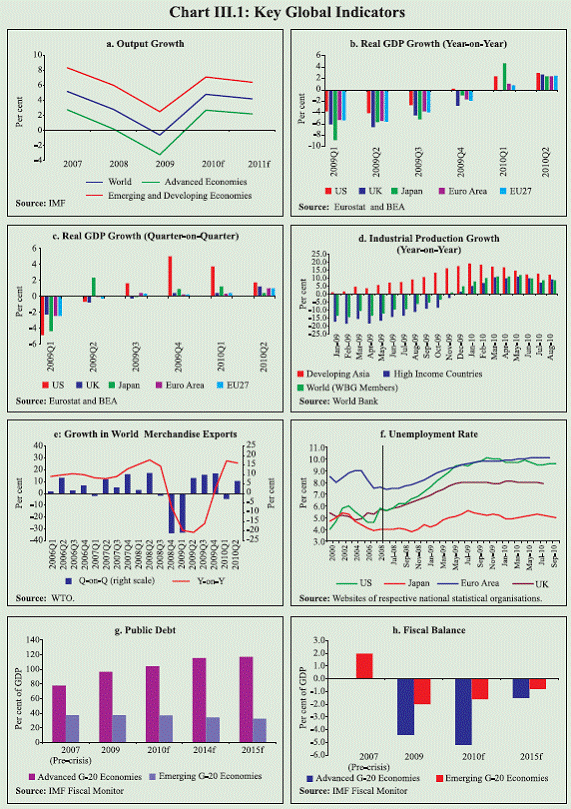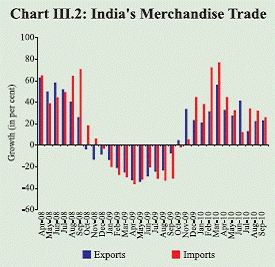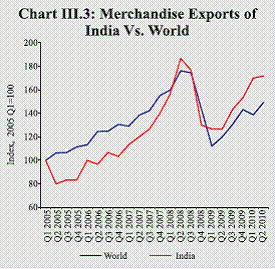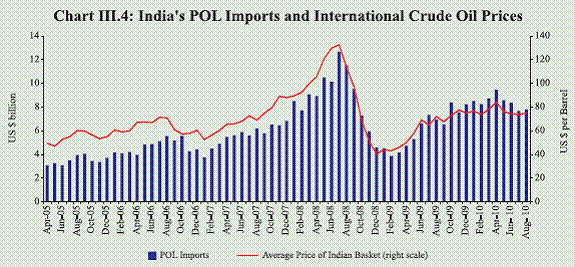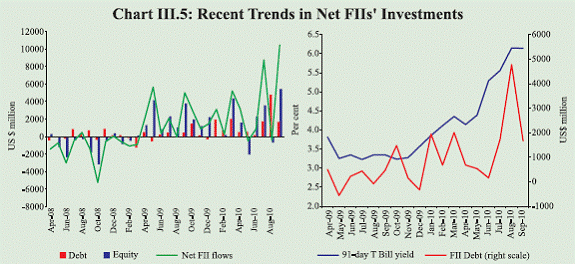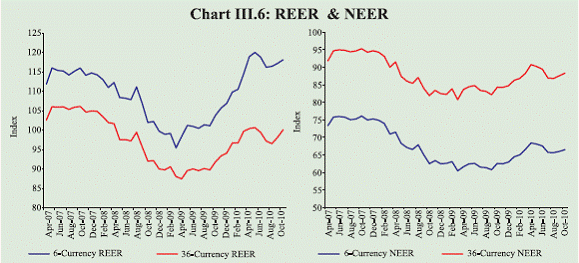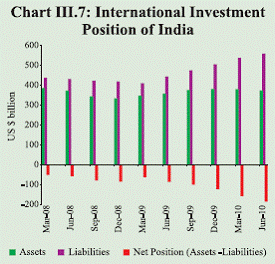III. The External Economy - ஆர்பிஐ - Reserve Bank of India
III. The External Economy
As renewed concerns about the strength of the global recovery started to dampen the external demand conditions, the impact of robust domestic growth was visible in the form of a higher current account deficit in the first quarter of 2010-11. While better absorption of foreign capital through a higher current account deficit contained the impact of surplus capital flows on the exchange rate, persistent positive inflation differential remained a source of pressure on external competitiveness of exports. Moreover, despite stronger absorption of capital inflows, the nominal exchange rate of the rupee appreciated against the US dollar. International Developments III.1 The global economy is projected to recover from -0.6 per cent growth recorded in 2009 to 4.8 per cent in 2010. This overall outlook, however, masks large divergence in the pace and nature of the recovery, both across countries and between the two halves of 2010. According to the IMF, in the advanced economies, growth is expected to halve from 3.50 per cent in the first half of the year to 1.75 per cent in the second half. Emerging and developing economies too are expected to witness a moderation in the pace of growth from 8 per cent in the first half to 6.25 per cent in the second half. The temporary slowdown is also believed to extend up to the first half of 2011. III.2 The global recovery lost momentum in the second quarter of the year, with the pace of recovery starting to slow down significantly in the advanced economies, particularly in the US and Japan (Chart III.1b & c). Growth in world industrial production also exhibited signs of deceleration after attaining peaks in March 2010 (Chart III.1d). Emerging Market Economies (EMEs), however, sustained the strong growth, and as a result, the asymmetry in growth widened further. While another short phase of contraction in economic activities in advanced economies, i.e., the fear of a double dip has receded, the feeble growth has reinforced concerns over deflation and high unemployment rates (Chart III.1f). With scope for fiscal stimulus already stretched to the point where sovereign risk concerns could be detrimental to recovery in growth, several central banks of advanced economies have signaled possible use of additional accommodative monetary policy stance (Chart III.1g & h). Unlike output, trade activities have recovered strongly, and the momentum has also been sustained (Chart.III.1e). Reflecting this, the WTO revised upwards its estimates for growth in merchandise trade volume to 13.5 per cent for 2010 from the previous estimates of 10.0 per cent, which will be the fastest ever year-on-year expansion in trade so far. This high growth, however, needs to be seen against the low base that resulted from sharp 12.2 per cent contraction experienced in 2009. Moreover, even though the value of merchandise trade expanded by 25 per cent in the first half of 2010, the level of activity still remains below the pre-crisis level. With deficient domestic demand, there have been signs of resorting to protectionism and undervalued exchange rates in some countries, which would hinder overall global recovery. The unemployment situation in general continues to be grim, and employment intensive recovery remains a major global policy challenge. According to the ILO’s August 2010 assessment of global employment trends for the youth, the global unemployment among youth (in the age group of 15 to 24) has increased from 11.9 per cent in 2007 to 13.0 per cent in 2009, which is expected to edge up further to 13.1 per cent in 2010. According to the IMF, unemployment has increased by 30 million since 2007, three fourth of which has been in advanced economies.
III.3 Developing Asia, according to the September 2010 assessment of the ADB, has sustained the momentum after witnessing a robust recovery, and is expected to grow at 8.2 per cent in 2010, as against 5.4 per cent in 2009. Recovery in both domestic demand and exports has contributed to this performance. End of the benefit of low base, fading policy stimulus and weaker growth in advanced economies in the second half of the year will be the major downside risks to growth. Risks to inflation could stem from buoyant domestic demand and rising commodity prices. The IIF revised upwards in October 2010 its assessment of private capital flows to EMEs for 2010 by US$ 116 billion from its April projections. Projected capital flows to EMEs in 2010 at US$ 825 billion will be significantly higher than US$ 581 billion in 2009. The Global Financial Stability Report, October 2010 notes that higher growth prospects and sounder fundamentals in EMEs point to a structural asset reallocation from advanced economies, which may increase volatility in portfolio capital flows and strain local market valuations in emerging market economies. III.4 The recent volatile external developments suggest that for the purpose of policy, their direct and indirect impact on the Indian economy and the financial system would have to be constantly assessed, and appropriate corrective policy response may have to be taken to deal with any visible signs of vulnerability. The asymmetry in growth relative to advanced economies would imply higher trade imbalance in India, which also has to recognise the risks from protectionism and exchange rate policies of other countries. The overall upbeat outlook for capital flows to EMEs suggests that given the robust domestic growth outlook and the increasing interest rate differentials after the calibrated normalisation of monetary policy, gross capital inflows in 2010-11 would be higher than what were expected a few months back. Merchandise Trade Exports III.5 India’s merchandise exports, which exhibited a robust recovery in the last quarter of 2009-10, continued to record high growth during the current financial year (Chart III.2). After recording a growth of 36.4 per cent during the fourth quarter of 2009-10, export growth has witnessed some moderation to 27.6 per cent this year during April-September. India’s export performance, however, remains better than the overall global trends (Chart III.3).
Imports III.6 Reflecting the demand associated with robust domestic growth, imports increased at a higher pace, though with some volatility during the year so far. Oil imports registered a growth of 54.8 per cent during the first quarter of 2010-11 on account of the combined effect of increase in volume along with higher international crude oil prices relative to the corresponding quarter of the previous year (Chart III.4). Non-oil imports increased by 33.7 per cent during April-August 2010, reflecting strong domestic demand conditions. III.7 Stronger growth in both oil and non-oil imports relative to exports resulted in a wider merchandise trade deficit during April-September 2010 at US$ 63.2 billion as compared with US$ 46.9 billion during the corresponding period of the previous year (Table III.3). Balance of Payments (BoP) Current Account III.8 The impact of the continuing asymmetry between robust growth in India and fragile recovery in the advanced economies was visible in the current account deficit, which expanded in the first quarter of 2010-11, relative to both previous quarter and corresponding quarter of the previous year (Table III.4). The trade deficit, on a BoP basis, was higher at US$ 34.2 billion in the first quarter of 2010-11 as compared with US$ 25.6 billion during corresponding period of 2009-10.
Invisibles III.9 India’s net surplus in the invisibles account (comprising services, income and transfers) declined during the first quarter of 2010-11 as compared to last year, mainly because of strong growth in services payments and decline in investment income receipts. The increase in services exports (by 22.5 per cent) during April-June 2010 was mainly due to a rise in services related to travel, and transportation as well as miscellaneous services such as software, business and financial services, which was largely offset by substantial expansion in services payments, particularly transportation, business and financial services. As a result, there was a net decline of 3.0 per cent in the services account. The invisibles surplus financed about 60.0 per cent of the trade deficit during the quarter as against about 83.0 per cent during the corresponding quarter of the previous year (Table III.5). Capital Account III.10 The net surplus in the capital account in the first quarter of 2010-11 exceeded the levels of the previous two quarters, as well as the financing need in the current account (Table III.6). There was a compositional shift across different components of capital flows during recent months. Foreign investment, which used to be a major constituent of the capital account, showed some moderation, mainly due to the slowdown in Foreign Direct Investment (FDI) inflows. Net inflows by FIIs were also lower during the quarter. FIIs, which were traditionally investing in equity market, started diversifying towards debt markets (Chart III.5). The attraction of the debt market could be attributed to the rising interest rate environment in India and the near zero interest rate conditions in advanced countries over an extended period. In order to support the development of vital infrastructure, to facilitate the transfer of power from energy surplus regions to underserved areas and to improve the quality of public services, India received large foreign capital in the form of external assistance during the quarter. Strong domestic demand along with the rising interest rate differentials also led to higher net inflows of External Commercial Borrowings (ECBs) during the quarter. Short-term trade credit to India recorded a large net inflow of US$ 5.6 billion in the first quarter of 2010-11 (as against a net outflow of US$ 1.5 billion during the corresponding quarter of 2009-10) in line with the increase in imports associated with strong domestic economic activity and improved conditions in the global financial markets. Banking capital recorded inflows of US$ 4.0 billion during the quarter, mainly due to overseas foreign currency borrowings of banks and net inflows under NRI deposits. Debt flows during the quarter at about US$12 billion accounted for almost 64 per cent of total net capital flows.
III.11 Available information on certain lead indicators of capital flows for the period 2010-11 so far shows some moderation in inflows in the form of FDI and NRI deposits, but larger net inflows under FIIs and ECBs (Table III.7). Debt flows, particularly ECBs, which are sensitive to interest rate differential, have been higher. FII flows have remained volatile during the year so far. They recorded net outflows in May 2010 but revived strongly in July recording net inflows of US$ 8.8 billion. Again, there were net outflows in August 2010, followed by net inflows in September 2010 at US$ 10.5 billion. Inflows in October increased to a record level of US$ 28.7 billion (up to October 22, 2010), which also reflected the over subscription of IPOs floated in the capital market. In this context, it may be noted that although many other Asian EMEs have also seen large capital inflows recently, India runs a current account deficit as opposed to current account surpluses in many other Asian economies.
Foreign Exchange Reserves III.12 As net capital flows were higher than the current account deficit, India’s foreign exchange reserves (excluding valuation effects) increased by US$ 3.7 billion during the first quarter of 2010-11 as compared to only a marginal increase of US$ 0.1 billion during the corresponding period of the previous year. Since the valuation loss on account of the appreciation of the US dollar against major international currencies amounted to about US$ 7 billion during April-June 2010, there was a net decline in the outstanding level of foreign exchange reserves by US$ 3.3 billion. India’s foreign exchange reserves stood at US$ 295.4 billion as on October 22, 2010 (Table III.8). Real Effective Exchange Rate of the Rupee III.13 The real effective exchange rate (REER) indices for both 6-currency and 36 currency baskets had exhibited significant appreciation in 2009-10. During 2010-11 so far (April-October 22, 2010), the 6-currency REER has recorded higher appreciation as compared with 36-currency REER (Chart III.6 and Table III.9). The 36-currency REER covers around 90 per cent of India’s foreign trade. If the positive inflation differentials persist, and the tendency among some countries to use undervalued exchange rates to boost their exports amplifies further, then the competitiveness of Indian exports may face pressures. The reason for the divergence between 6- currency REER and 36-currency REER indices could be seen from the movement in the 30-currency REER index, which excludes 6 currencies (covered in the 6- currency REER). India’s inflation differentials with respect to 6 major countries included in the 6-currency REER have been higher than that with respect to other EMEs in the 30-currency index.
External Debt III.14 India’s external debt stock at US$ 273.1 billion at end-June 2010 recorded an increase of US$ 10.8 billion over its level at end-March 2010, mainly on account of significant increase in short-term trade credits, ECBs and multilateral borrowings of the Government. Excluding valuation effects resulting from the appreciation of the US dollar against major international currencies, India’s external debt increased by US$ 12.1 billion. As at end-June 2010, the share of short-term debt in total external debt based on original maturity was 21.2 per cent, while based on residual maturity its share was higher at 42.5 per cent. The key debt sustainability indicators remained at comfortable levels as at end-June 2010 (Table III.10). International Investment Position III.15 India’s net international liabilities increased by US$ 26.8 billion during the first quarter of 2010-11 mainly due to increase in net inflows under trade credits and loans along with FDI and portfolio investment. Total external financial assets decreased by US$ 5.3 billion to US$ 373.6 billion as at end-June 2010 over the previous quarter due to decline in reserve assets and trade credits. The reserve assets declined by US$ 3.4 billion due to the valuation loss, reflecting appreciation of the US dollar against major international currencies. Total international financial liabilities increased by US$ 21.4 billion over the previous quarter to US$ 558.7 billion as at end-June 2010 (Chart III.7).
III.16 Overall, India’s balance of payments situation reflected the impact of robust domestic growth, which was visible in the wider current account deficit. The upbeat growth outlook of India and rising interest rate differentials have contributed to attract larger net capital inflows, which financed the current account deficit. Going forward, the magnitude of the current account deficit may exceed the levels of the previous year, as asymmetry between the growth outlook of India and the developed countries is likely to persist, which will be reflected in export growth lagging behind import growth during the year. Recent outlook for capital flows to EMEs suggests that after the temporary uncertainty created by the sovereign risk concerns in the Euro area, capital flows to EMEs will be stronger. Although financing of the current account deficit may not be a problem, possible increase in the magnitude of the deficit could pose sustainability risks. Sustainable current account deficit is important for stable growth, and persisting high positive inflation differential will be a source of pressure on the external competitiveness of Indian exports. Containing inflation, thus, is important even for improving the external balance position.
|
||||||||||||||||||||||||||||||||||||||||||||||||||||||||||||||||||||||||||||||||||||||||||||||||||||||||||||||||||||||||||||||||||||||||||||||||||||||||||||||||||||||||||||||||||||||||||||||||||||||||||||||||||||||||||||||||||||||||||||||||||||||||||||||||||||||||||||||||||||||||||||||||||||||||||||||||||||||||||||||||||||||||||||||||||||||||||||||||||||||||||||||||||||||||||||||||||||||||||||||||||||||||||||||||||||||||||||||||||||||||||||||||||||||||||||||||||||||||||||||||||||||||||||||||||||||||||||||||||||||||||||||||||||||||||||||||||||||||||||||||||||||||||||||||||||||||||||||||||||||||||||||||||||||||||||||||||||||||||||||||||||||||||||||||||||||||||||||||||||||||||||||||||||||||||||||||||||||||||||||||||||||||||||||||||||||||||||||||||||||||||||||||||||||||||||||||||||||||||||||||||||||||||||||||||||||||||||||||||||||||||||||||||||||||||||||||||||||||||||||||||||||||||||||||||||||||||||||||||||||||||||||||||||||











